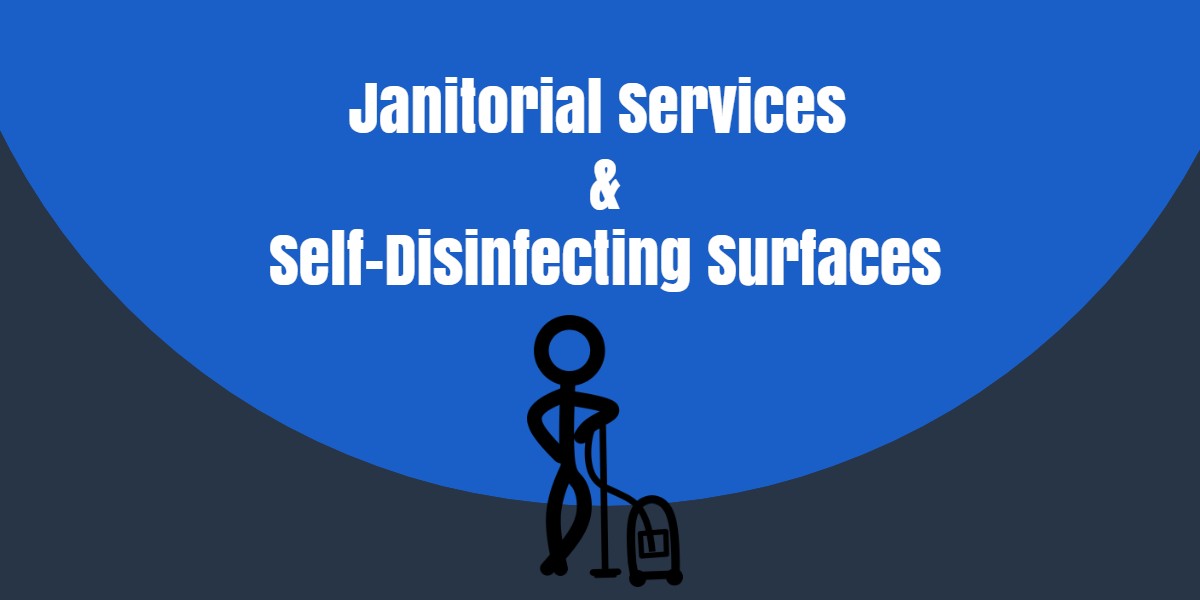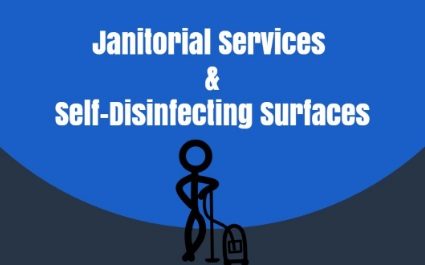Outsourcing your organization's janitorial services, combined with the implementation of self-cleaning surfaces, is a cost-effective method for improving your facilities' health and performance.

The Advantages of Outsourcing Janitorial Services Combined With Self-Disinfecting Surfaces
Emerging technological advancements in self-disinfecting surfaces are changing the way we think about clean, especially in healthcare environments where patients and workers are exposed to a higher risk of infection.
Currently, several methods exist, including:
- Surface coating.
- Photoactivation, and;
- Heavy metal impregnation.
Surface Coating
Coating and surface modification can be used to treat equipment that is already in place but was not constructed with the purpose of self-disinfection in mind.
The most common practice is to sterilize the room and all of the equipment, then apply an antimicrobial coating, followed by an oxidizing photocatalytic layer, with an electrostatic appliance, allowing for full surface coverage with minimal effort.
The antimicrobial coating keeps the surface clean, while the photocatalytic layer attracts negatively charged germs and bacteria, oxidizing and killing them between cleanings.
For More Information:
Photoactivation
Another approach to surface modification is to construct materials coated with a photoactive compound, such as titanium oxide.
When exposed to UV lighting, the combination of UV and titanium oxide cause a chemical reaction that releases superoxide and hydrogen radicals.
The antimicrobial process that follows has been shown to damage the cell walls of bacteria, causing death due to molecular leakage.
Recent studies have demonstrated the potential benefits of photoactivation in the food service and healthcare industries.
According to a 2013 research article published by AMB Express;
[...] results obtained indicates that the TiO2-coated surfaces show antibacterial activity with all microorganisms tested highlighting that the titania could be used in the ceramic and building industry for the production of coated surfaces to be placed in microbiologically sensitive environments, such as the hospital and food industry.
Photocatalytic bacterial inactivation by TiO2-coated surfaces
Heavy Metal Impregnation
The use of heavy metals to fight infection has a long history.
According to the American Journal of Infection Control;
[...] more than 30 heavy metals are potentially able to interact with microorganisms including silver (Ag), gold (Au), bismuth (Bi), cobalt (Co), copper (Cu), iron (Fe), mercury (Hg), manganese (Mn), nickel (Ni), lead (Pb), platinum (Pt), antimony (Sb), tin (Sn), titanium (Ti), and zinc (Zn).
It has been known since antiquity that some heavy metals possess anti-infective activity.
Among the use of heavy metals to prevent or treat infections have been the use of copper-clad ships to resist the growth of barnacles; mercurials, arsenic derivatives and bismuth compounds to treat syphilis; silver nitrate to prevent gonococcal neonatal conjunctivitis, and silver compounds as topic agents to prevent infection in burn patients.
Despite the fact that modern antibiotics have largely replaced heavy metal therapeutics for treating infection, intense research is being conducted into the use of heavy metal containing complexes (platinum, copper, zinc, and gold) for the treatment of cancer and metal-based drugs (antimony, ruthenium, gold, platinum, palladium, and zinc) for the treatment of malaria, trypanosomiasis, and leishmaniasis.
Self-disinfecting surfaces: Review of current methodologies and future prospects
Additionally, several recent studies have established the efficacy of copper coated surfaces for multiple products in healthcare environments.
According to research conducted by Aston University at Selly Oak Hospital;
At Selly Oak, a range of products such as grab rails, door handles, light switches, taps, over-bed tables and toilet seats, were replaced with copper surfaces.
The results showed that with normal cleaning, the copper surfaces were found to have up to 90% fewer organisms on them than items made from other materials such as stainless steel.
While other agents such as chlorine and hydrogen peroxide have had similar short-term effects, copper has the longest lasting impact.
References & Resources
Takeaway
Surface coating and modification, the construction of building materials with photoactive compounds, as well as high-contact surfaces made from heavy metals, such as copper, have demonstrated the ability to cost-effectively kill germs and bacteria while resisting the growth of biofilm.
According to Anton Paar;
Maintenance-free sterile surfaces are a promising strategy to meet the requirement of long-term antimicrobial activity.
The mechanism of the antimicrobial activity of polymers by mere contact has not yet been understood, though positive charges are known to play an important role.
Self-Disinfectant Surfaces - Correlation between Antimicrobial Activity and Zeta Potential
However, the surfaces require regular cleaning to maintain their efficacy.
Combining self-disinfecting surfaces with certified green cleaning services through an outsourced custodial provider can significantly improve the health and performance of your facility and employees, especially in the food service and healthcare industries.
If you would like to learn more about the advantages of outsourced janitorial services, combined with the power of self-disinfecting surfaces –contact us today for a free quote!
In Bakersfield CA, call (661) 437-3253
In Fresno CA, call (559) 206-1059
In Valencia CA, or Santa Clarita CA, call (661) 437-3253

